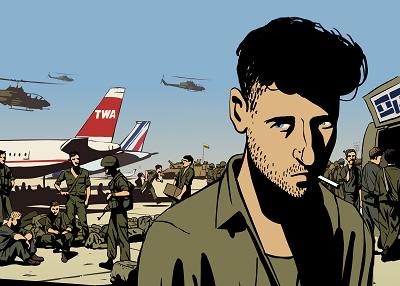Posted January 9, 2009
This is a moment when it’s hard to remember why art matters, let alone art that highlights the voices of those who – knowingly or not — perpetrate oppression.
Waltz with Bashir, Ari Folman’s animated hit about his effort to uncover repressed memories of his military experience in Lebanon in 1982, reached New York theaters a couple of weeks before Israel’s most recent invasion of Gaza. It was released in Israel in June 2008, the same month that the now defunct Hamas-Israel ceasefire was forged.
It was greeted by voluminous praise in Israel and in the west, snapping up six awards from the Israeli Film Academy, including best picture. It was praised highly by New York Times and the BBC and featured competitively at Cannes.
Reception in the Arab world was mixed. The film is banned in Lebanon, and some leftists – Arab and otherwise — point out that the film was enthusiastically supported by the Israeli state as a way to reconfigure its occupying soldiers as victims. Others have criticized what they see as the film’s unwillingness to lay the blame for the Sabra and Shatila massacre fully on Israel.
In some sense, though, it’s a timely release. Israel’s expectation that Palestinians will blame Hamas for Israeli-perpetrated deaths, along with its stunning unwillingness to acknowledge the human suffering that it has actively precipitated — just think of foreign minister Tzipi Livni’s comment that “there’s no humanitarian crisis in Gaza” — are represented in Waltz with Bashir with sickening familiarity.

The film consists of a series of interviews with Folman’s ex-army buddies twenty years after the eponymous massacres at Sabra and Shatila. Bit by bit, the friends – including a chain smoking ex-falafel seller now living in Holland and a psychologist who insists Folman’s obsession with the Lebanon war is a cover for his “real” obsession with the Nazi Holocaust—prompt Folman to piece together his experience in its entirety.
By the end he recalls lighting flares from the rooftops of adjacent buildings while Phalangist militiamen execute Palestinian families in the courtyards of their homes, and finally of standing in the street as survivors stumble, ghostlike, through the alleyways of the camps.
The film is animated until the last moment when it cuts to a short reel of live footage documenting the aftermath of the massacres. Women moan in front of piles of rubble and human bodies, and the camera zooms in on insects crawling across a slain child’s face.
Thus Folman uncovers his memory, but his questions about his own responsibility linger. The friend who insists that he shouldn’t feel guilty because he didn’t “pull the trigger” is clearly discounted, since the supposedly cathartic process of filmmaking has left him with nothing but horror.
I saw Waltz with Bashir on New Years Eve, about four days into the current Israeli invasion. It was impossible not to be moved. It is luminously animated and emotionally gripping. Like all good works of art it poses big questions – the reliability of human memory, the nature of culpability and atonement — and answers them in small ways.
I was also acutely conscious of being pulled into a relationship of empathy with an Israeli solider struggling with a 25-year-old memory of an atrocity bearing similarities to those that are occurring in Gaza now.
Novelist Richard Flanagan commented that an element of successful fiction is that it “takes the reader beyond his own history and character, escapes the shackles of his politics and opinions.” This film is a reminder that this is can be an unsettling process.
Waltz with Bashir proves that art is still possible in a world where the overnight mobilizations of hundreds of thousands of protestors, let alone the lessons of the 20th century, have failed to stop a state-orchestrated massacre against an impoverished refugee population. Those who care about human liberation and all that it entails – empathy, passion, art — should take that as call to rise up.
